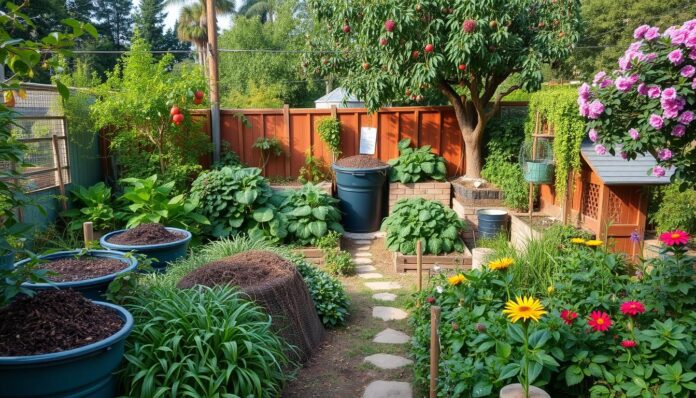Imagine if we could change how we manage waste to make our ecosystems sustainable. Permaculture, a model for sustainable farming, shows us how. It teaches us to care for the earth and recycle natural resources. By using permaculture methods, we can cut down on waste and support growth.
Permaculture aims to create ecosystems that are as diverse and resilient as nature. By choosing eco-friendly building materials, we can reduce waste and work more efficiently. This method helps cut down on packaging waste and lowers emissions by using local resources.
Key Takeaways
- Permaculture materials recovery reduces waste and promotes regenerative design
- Sustainable construction materials and eco-friendly building supplies minimize waste
- Local sourcing cuts transportation emissions and reduces packaging waste
- Permaculture systems produce richer nutrition outputs compared to conventional monoculture systems
- Community sharing initiatives and composting can significantly reduce food waste and improve soil quality
- Utilizing ollas and greywater management can ensure efficient water use
Understanding Permaculture Principles
Permaculture is a way to use land and resources without waste. It creates closed-loop systems like nature. It focuses on sustainable resource management and regenerative design materials for productive, non-polluting systems.
The core of permaculture is observing nature. This helps create systems that are strong and can take care of themselves. By using permaculture, people can help make green building materials and lessen their environmental impact.
The Importance of Sustainable Systems
Sustainable systems keep ecosystems balanced and support biodiversity. They offer many benefits, including:
- Reduced soil erosion and better soil health
- Less water use and better water retention
- Less need for chemical fertilizers and pesticides
Key Permaculture Concepts
Permaculture ideas like mulching and swales help save water and keep soil moist. Using biological resources in permaculture also makes farming healthier and more productive.
The Role of Waste in Ecosystems
Waste is important in ecosystems, and permaculture aims to reduce it. By understanding waste’s role, people can apply permaculture better. This helps with sustainable resource management.
| Permaculture Practice | Benefits |
|---|---|
| Mulching | Minimized water usage and improved water retention |
| Swales | Improved soil health and reduced soil erosion |
Identifying Common Waste Streams
Managing waste well is key to saving our planet. In a circular economy, we reuse and recycle resources, cutting down on waste. But, our current way of life often leads to a lot of waste, harming our environment. It’s important to know what kinds of waste we produce, like organic, plastic, and electronic waste.
Using circular economy resources like composting can turn food and yard waste into valuable soil. This method helps reduce waste and gives us sustainable architecture supplies for building and gardening. Also, using eco-conscious construction materials helps build green buildings, lowering the environmental harm from construction.
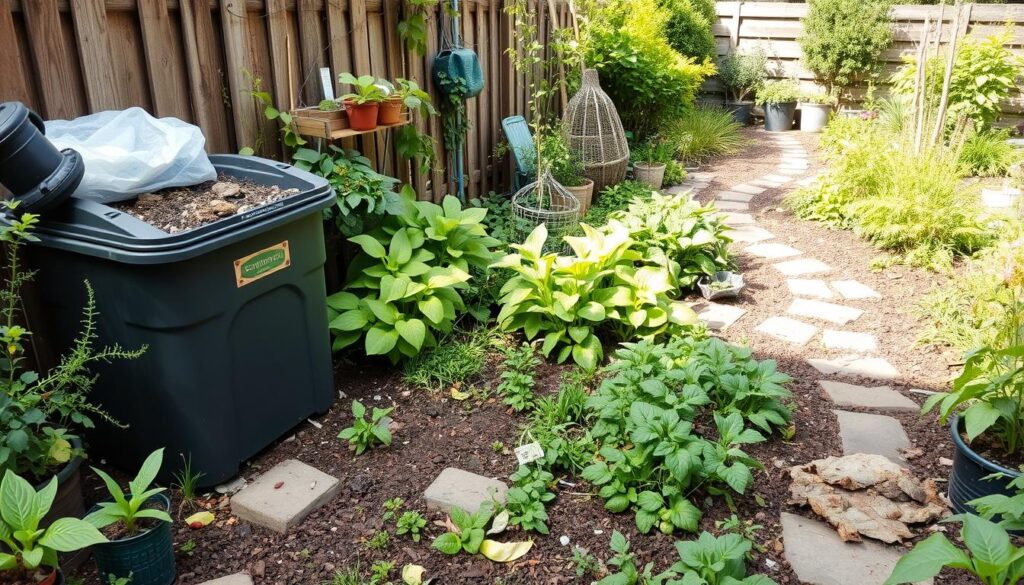
- Organic waste: food scraps, yard debris, and agricultural waste
- Plastic and packaging waste: single-use plastics, packaging materials, and microbeads
- E-waste: electronic devices, batteries, and other electronic waste
Knowing where our waste comes from and how it affects us helps us find ways to reduce it. We can start by recycling, composting, and properly handling e-waste.
| Waste Stream | Environmental Impact | Sustainable Solution |
|---|---|---|
| Organic Waste | Soil and water pollution | Composting and anaerobic digestion |
| Plastic and Packaging Waste | Marine pollution and waste accumulation | Recycling and biodegradable packaging |
| E-waste | Toxic pollution and electronic waste accumulation | Responsible recycling and electronic device reuse |
The Benefits of Waste Stream Management
Managing waste streams is key to reducing our environmental impact and supporting sustainable growth. By using permaculture materials recovery and sustainable building supplies, we can build systems that waste less and support more life. This not only helps the planet but also cuts down on the need for harmful synthetic materials.
Some of the main advantages of managing waste streams include:
- Soil health gets a boost from nutrient-rich compost and fertilizers
- Less need for harmful synthetic fertilizers and chemicals
- Water use goes down with the use of diluted urine as fertilizer
- Resources are saved and pollution lessened through recycling and composting
By adopting these methods, homes can greatly cut down their waste and help create a greener future. Using permaculture and sustainable materials also helps biodiversity, which is vital for a healthy ecosystem. With over 2 billion tons of waste made every year, it’s crucial to use effective waste management to protect our environment and lower emissions.
By closing the loop in permaculture and choosing eco-friendly building supplies, we can build a more sustainable world. This approach needs a mix of nitrogen-rich and carbon-rich materials, along with good composting to turn waste into valuable compost. By doing this, we can lessen our impact on the environment and work towards a greener future.
| Benefits of Waste Stream Management | Environmental Impact |
|---|---|
| Enhanced soil health | Reduced greenhouse gas emissions |
| Conservation of resources | Reduced pollution |
| Increased water efficiency | Reduced waste generation |
Techniques for Managing Organic Waste
Managing organic waste is key for a sustainable future. It means finding ways to reduce waste and turn it into useful things like soil. This helps in using materials that are good for the planet.
There are many ways to handle organic waste. You can compost, use Bokashi fermentation, or vermicomposting. These methods help cut down on landfill waste and protect our environment.
Composting: Turning Waste into Wealth
Composting turns waste into a valuable soil amendment. It needs a mix of carbon and nitrogen and the right moisture. Turning the compost pile often is important to keep it healthy.
Bokashi Fermentation System
Bokashi fermentation uses microbes to break down waste. It’s great for small spaces, like cities, to handle food and other organic waste.
Vermicomposting with Earthworms
Vermicomposting uses worms to speed up composting. It makes compost that’s richer in nutrients. The system needs a mix of green and brown materials for the worms and compost.
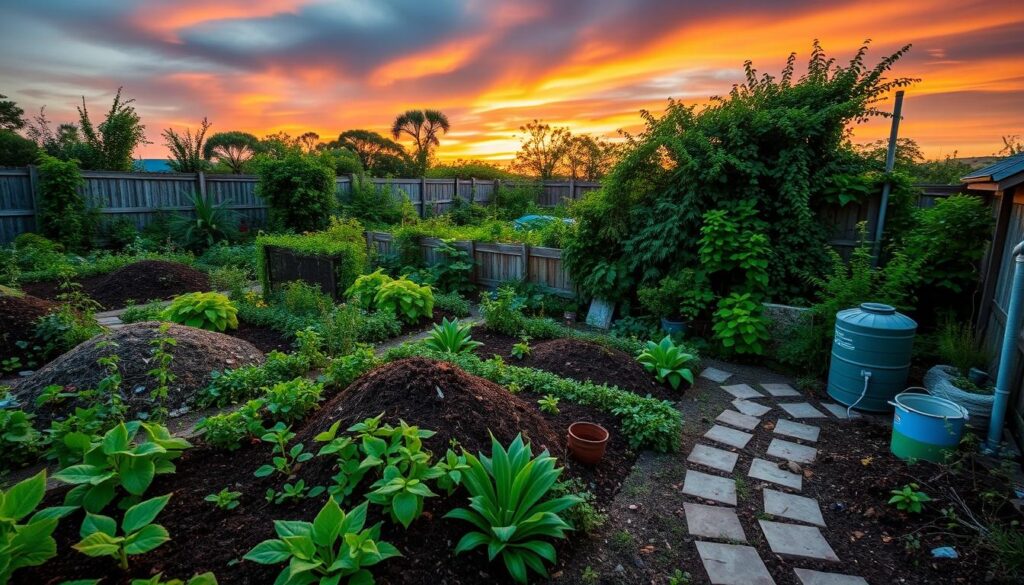
| Technique | Benefits | Space Requirement |
|---|---|---|
| Composting | Reduces landfill waste, produces nutrient-rich soil amendment | Minimum 4’x4’x4’ |
| Bokashi Fermentation | Manages food waste, suitable for urban settings | Limited space required |
| Vermicomposting | Accelerates composting process, produces high-nutrient compost | Space required for worm habitat |
Utilizing Greywater in Permaculture
Greywater is a big part of household wastewater, making up half to more than half. It’s a valuable resource in permaculture. Using greywater helps reduce water use and supports a circular economy.
This approach makes living more sustainable. It values resources and cuts down on waste.
Greywater is good for permaculture in many ways. For instance, it can save 25 to 45 gallons of water per person daily. That’s over 1,000 gallons a month. It also lowers the need for sustainable architecture supplies and eco-conscious construction materials in gardens.
It’s key to use greywater safely. The water might have sodium, potassium, and other contaminants. But with the right eco-conscious construction materials and system design, risks are lowered. This makes the environment more circular economy friendly.
Using greywater in permaculture has many benefits. Some are:
- Less water used
- Less wastewater made
- More use of circular economy resources
- More use of sustainable architecture supplies and eco-conscious construction materials
Recycling and Repurposing Non-Organic Waste
Recycling and repurposing non-organic waste is key in permaculture. It helps save resources and cuts down landfill waste. Using sustainable materials and eco-friendly supplies can greatly reduce our environmental impact. For instance, upcycling old items like containers and packing materials can extend their life. This reduces the need for new, resource-heavy products.
Here are some creative ways to reuse non-organic waste:
- Turn old pallets into planters or furniture
- Make decorative items or building materials from recycled glass or plastic
- Convert old tires into planters or garden features
These ideas not only cut down waste but also support a circular economy. They encourage the use of sustainable materials and eco-friendly supplies.
Permaculture materials recovery is vital for a zero-waste lifestyle. Embracing recycling and repurposing can have a big environmental impact. With the world producing about 2.01 billion tons of waste each year, it’s crucial to manage waste responsibly. Practices like the 3Rs (Reduce, Reuse, Recycle) help reduce waste and promote eco-friendly building supplies.
By opting for sustainable materials and eco-friendly supplies, we can live more environmentally conscious. This supports permaculture materials recovery and lessens our ecological footprint.
Creating a Permaculture Design Plan
Creating a permaculture design plan is key for managing waste and resources. It maps out waste streams and uses local resources. It also sets goals for sustainable practices.
When making a plan, observe the site and understand the local climate. Tools like PA Yeoman’s Scales of Permanence help. They guide you from climate to soil. Adding permaculture principles, like efficient water use, makes the design more sustainable.
Mapping Out Waste Streams
Identifying waste sources and recycling options is crucial. This step helps reduce waste and manage resources better. Composting and vermicomposting turn waste into valuable resources, cutting down on external inputs.
Integrating Local Resources
Using local materials and ecosystems is essential for a sustainable design. It reduces environmental impact and supports local biodiversity and economy. This approach makes the design more sustainable and beneficial to the community.
Setting Realistic Goals
Setting achievable goals is vital for a permaculture project’s success. Assess the site’s potential and plan for gradual growth. Realistic goals keep the project on track and sustainable over time. Regularly observing and adapting to feedback ensures success.
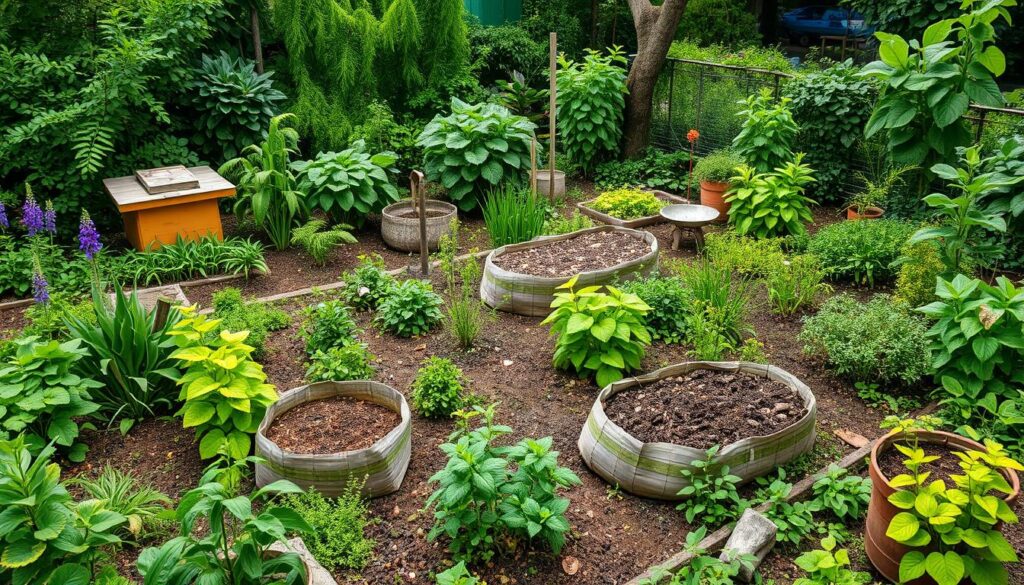
| Permaculture Principle | Description |
|---|---|
| Observe and Interact | Observe nature and interact with the environment to understand its patterns and rhythms. |
| Catch and Store Energy | Capture and store energy from the environment to reduce reliance on external inputs. |
| Obtain a Yield | Ensure that the design provides a yield, whether it be food, materials, or services, to justify the investment of time and resources. |
By following these principles, you can create a permaculture plan. It manages waste, promotes sustainability, and uses green materials. This leads to a more sustainable future.
Collaborating with the Community
Working together is key to spreading circular economy resources and sustainable architecture supplies. By joining forces, we can share knowledge and skills. This helps make our environment more eco-conscious.
Building local waste exchange networks is a great way to start. Here, people can swap materials and cut down on waste. It’s a step towards a greener future.
Teaching others about eco-conscious construction materials and sustainable architecture supplies is also vital. Community workshops and training sessions can do this. They help people learn about permaculture and sustainable living.
With education, community members become more aware and skilled. This leads to a stronger, more circular economy.
Here are some ways to collaborate:
- Building local waste exchange networks
- Organizing community events and awareness campaigns
- Providing educational opportunities and training sessions
- Collaborating with local organizations and government agencies
Together, we can make our community more sustainable and eco-conscious. This means less waste and more efficient use of resources. It also makes our community stronger.
| Community Collaboration | Benefits |
|---|---|
| Building local waste exchange networks | Reduces waste, promotes sustainability |
| Organizing community events and awareness campaigns | Raises awareness, promotes education |
| Providing educational opportunities and training sessions | Enhances ecological literacy, self-sufficiency |
Monitoring and Adapting Waste Practices
Effective waste management in permaculture means always watching and changing how we do things. We track how much waste we make and how we manage it. This helps us find ways to do better.
By doing this, we can make our waste management better. We use more sustainable materials and eco-friendly supplies. This helps the planet.
Important parts of watching and changing waste practices are:
- Tracking waste generation to understand patterns and areas for reduction
- Implementing sustainable construction materials in building projects
- Utilizing eco-friendly building supplies to minimize environmental impact
By using permaculture in our daily lives, we can greatly reduce harm to the environment. This ongoing effort helps us get better at managing waste. It leads to a greener future.
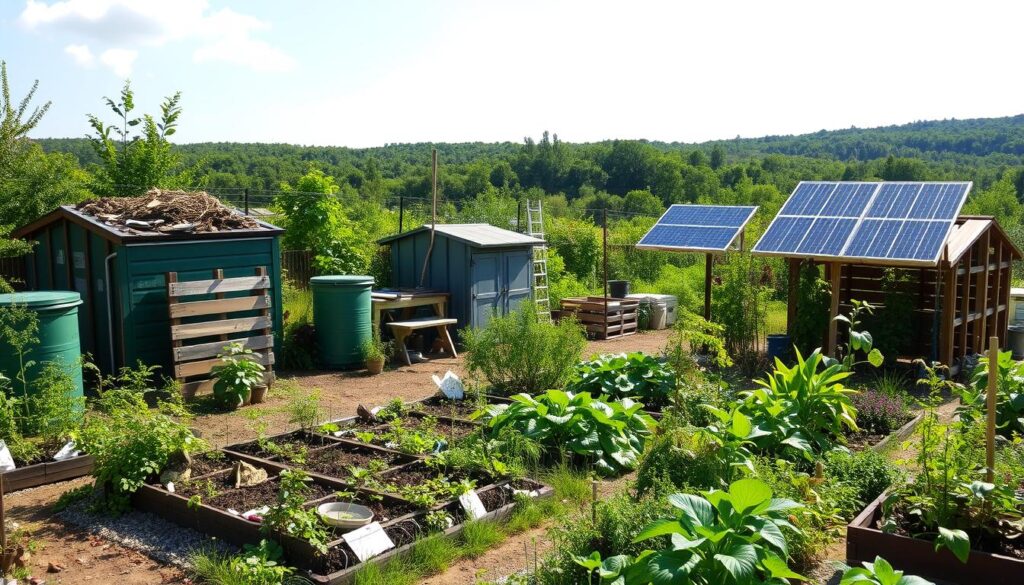
Following permaculture’s principles, like caring for the Earth and sharing fairly, helps us manage waste better. As we and our communities follow these ideas, we see many benefits. Our soil gets healthier, and pollution goes down.
Innovations in Waste Stream Management
It’s key to use sustainable resource management to lessen harm to our planet. New tech in recycling and composting has emerged. These advancements help us use regenerative design materials and green building materials, moving us towards a circular economy.
The U.S. Department of Agriculture is offering $900,000 to local governments. They want to help with compost and food waste reduction projects. This will help communities, the environment, farmers, and gardeners. For more details, check out the USDA website about these projects.
Here are some examples of new ways to manage waste:
- AgriProtein uses black soldier fly larvae to turn organic waste into protein meal and oil.
- The Ocean Spray eco-resort in Barbados has over 80 fruit trees and edible plants.
- A recycling center in Blantyre, Malawi, makes high-grade compost from organic waste.
These new methods show how sustainable resource management can cut down waste. They also encourage the use of regenerative design materials and green building materials. By adopting these changes, we can all help the environment and support sustainable growth.
| Project | Location | Impact |
|---|---|---|
| AgriProtein | Africa | Produces 5,000 tons of high-protein meal and 2,000 tons of oil annually |
| Ocean Spray eco-resort | Barbados | Features over 80 different types of fruit trees and edible plants |
| Recycling center | Blantyre, Malawi | Converts organic waste into high-grade compost for consumers |
Overcoming Challenges in Waste Management
Effective waste management is key for a circular economy. It uses resources well and reduces waste. But, many challenges make it hard to manage waste sustainably. One big issue is not knowing how important eco-conscious construction materials and sustainable architecture supplies are.
The World Health Organization (WHO) says about 2 billion people didn’t have waste collection. And 3 billion lacked safe places for waste disposal before COVID-19. This shows we need new ways to manage waste. We should use circular economy resources and sustainable architecture supplies.
To beat these challenges, we must get everyone involved. We need to teach people about eco-conscious construction materials and sustainable architecture supplies. We also need to offer rewards for using these sustainable options.
Common Barriers and Solutions
- Lack of awareness about sustainable waste management practices
- Insufficient access to circular economy resources and sustainable architecture supplies
- High costs associated with implementing sustainable waste management practices
Engaging Stakeholders in Practices
Getting everyone involved is vital for using eco-conscious construction materials and sustainable architecture supplies. We can do this by working together, teaching, and spreading the word. This helps make a better circular economy.
| Stakeholder | Role in Waste Management |
|---|---|
| Individuals | Adopting sustainable practices, reducing waste generation |
| Communities | Implementing community-wide waste management programs, promoting education and awareness |
| Organizations | Providing sustainable architecture supplies and eco-conscious construction materials, supporting waste reduction initiatives |
Inspirational Case Studies in Waste Management
Let’s look at some inspiring examples of waste management in permaculture. These stories show how permaculture can change the game. They highlight the use of sustainable materials and eco-friendly building supplies.
In Ghana, the GCFRP program has boosted cocoa production from 400 to 600 kg per hectare since 2019. It has also cut down deforestation and forest damage by nearly 1 million tons of emissions. In Ethiopia, the Soddo project has restored 503 hectares of native forests. It has planted over 1.2 million trees and saved about 189,027 tonnes of CO2 emissions.
In Africa, projects like the Hifadhi-Livelihoods in Ethiopia and the Kitalu project in Kenya are making a big difference. They use tree planting, sustainable farming, and carbon credits to make a positive impact. These stories give us hope and encourage others to adopt permaculture principles.

